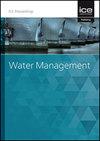软计算模型在水流预报中的应用
IF 0.9
4区 工程技术
Q3 ENGINEERING, CIVIL
Proceedings of the Institution of Civil Engineers-Water Management
Pub Date : 2019-05-01
DOI:10.1680/JWAMA.16.00075
引用次数: 24
摘要
通过交叉验证方法,对5种软计算技术在吉尔吉特河流域月流量预测中的准确性进行了评估。评估的五种技术分别是前馈神经网络(FFNN)、径向基神经网络(RBNN)、广义回归神经网络(GRNN)、网格划分自适应神经模糊推理系统(anfisi - gp)和减法聚类自适应神经模糊推理系统(anfisi - sc)。研究中考虑了温度与水流的相互作用。采用均方误差(MSE)和决定系数(R2)两项统计指标评价模型的性能。在所有应用中,RBNN和anfiss - sc模型比FFNN、GRNN和anfiss - gp模型给出了更准确的结果。通过在应用模型中加入周期性分量,考察了周期性的影响,并将结果与统计模型(季节性自回归综合运动模型)进行了比较。本文章由计算机程序翻译,如有差异,请以英文原文为准。
Application of soft computing models in streamflow forecasting
The accuracy of five soft computing techniques was assessed for the prediction of monthly streamflow of the Gilgit river basin by a cross-validation method. The five techniques assessed were the feed-forward neural network (FFNN), the radial basis neural network (RBNN), the generalised regression neural network (GRNN), the adaptive neuro fuzzy inference system with grid partition (Anfis-GP) and the adaptive neuro fuzzy inference system with subtractive clustering (Anfis-SC). The interaction between temperature and streamflow was considered in the study. Two statistical indexes, mean square error (MSE) and coefficient of determination (R2), were used to evaluate the performances of the models. In all applications, RBNN and Anfis-SC were found to give more accurate results than the FFNN, GRNN and Anfis-GP models. The effect of periodicity was also examined by adding a periodicity component into the applied models and the results were compared with a statistical model (seasonal autoregressive integrated movi...
求助全文
通过发布文献求助,成功后即可免费获取论文全文。
去求助
来源期刊
CiteScore
2.10
自引率
0.00%
发文量
28
审稿时长
6-12 weeks
期刊介绍:
Water Management publishes papers on all aspects of water treatment, water supply, river, wetland and catchment management, inland waterways and urban regeneration.
Topics covered: applied fluid dynamics and water (including supply, treatment and sewerage) and river engineering; together with the increasingly important fields of wetland and catchment management, groundwater and contaminated land, waterfront development and urban regeneration. The scope also covers hydroinformatics tools, risk and uncertainty methods, as well as environmental, social and economic issues relating to sustainable development.

 求助内容:
求助内容: 应助结果提醒方式:
应助结果提醒方式:


